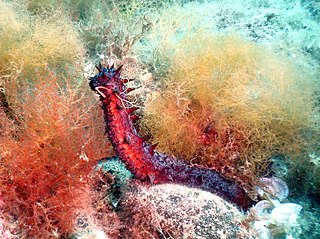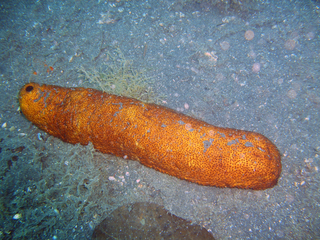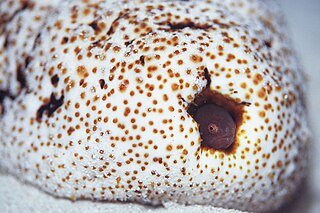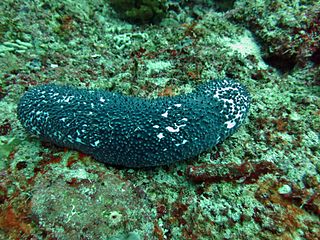
The California sea cucumber, also known as the giant California sea cucumber, is a sea cucumber that can be found from the Gulf of Alaska to Baja California. It is found from the low intertidal zone to a depth of 250 m (820 ft). They are most abundant in areas with moderate current with cobbles, boulders or bedrock. They are artisanally fished.

Holothuriida is an order of sea cucumbers. Taxa within the order Holothuriida were previously classified in the order Aspidochirotida, which was determined to be polyphyletic in 2017. Some taxa were also reclassified into the clades Synallactida and Persiculida.

Holothuria atra, commonly known as the black sea cucumber or lollyfish, is a species of marine invertebrate in the family Holothuriidae. It was placed in the subgenus Halodeima by Pearson in 1914, making its full scientific name Holothuria (Halodeima) atra. It is the type species of the subgenus.
The worm pearlfish is an eel-like fish in the family Carapidae.

Holothuria forskali, the black sea cucumber or cotton-spinner is a species of sea cucumber in the family Holothuriidae. It is found at shallow depths in the eastern Atlantic Ocean and the Mediterranean Sea. It was placed in the subgenus Panningothuria by Rowe in 1969 and is the type taxon of the subgenus.

Holothuria tubulosa, the cotton-spinner or tubular sea cucumber, is a species of sea cucumber in the family Holothuriidae. It is the type species of the genus Holothuria and is placed in the subgenus Holothuria, making its full name Holothuria (Holothuria) tubulosa.

Bohadschia is a genus of sea cucumbers in the family Holothuriidae. They are among the largest, most common, and conspicuous sea cucumbers on coral reefs. They have large, loaf-like bodies that are often strikingly colored.
The star pearlfish, Carapus mourlani, is a species of slender, ray-finned fish in the family Carapidae. It normally lives inside a starfish or a sea cucumber.

Bohadschia marmorata, commonly known as the brown sandfish or chalky cucumber, is a species of sea cucumber in the family Holothuriidae. It lives on the seabed in shallow waters in the Indo-Pacific region.

Pearsonothuria is a genus of sea cucumbers in the family Holothuriidae. Pearsonothuria graeffei is the only species in the genus. Graeffe's sea cucumber is found in the tropical Indo-Pacific Ocean and the type locality is Viti Island, Fiji. It is named after Eduard Heinrich Graeffe, Semper's coworker at the Museum Godeffroy.

Holothuria leucospilota, commonly known as the black sea cucumber or black tarzan, is a species of marine invertebrate in the family Holothuriidae. It is placed in the subgenus Mertensiothuria making its full scientific name Holothuria (Mertensiothuria) leucospilota. It is the type species of the subgenus and is found on the seabed in shallow water in the Indo-Pacific.

Cuvierian tubules are clusters of fine tubes located at the base of the respiratory tree in some sea cucumbers in the genera Bohadschia, Holothuria and Pearsonothuria, all of which are included in the family Holothuriidae. The tubules can be discharged through the anus when the sea cucumber is stressed. They lengthen when they come into contact with seawater and become adhesive when they encounter objects, functioning as a form of defense against predators or sources of danger. They are named after the French zoologist Georges Cuvier, who first described them.

The pinhead pearlfish, Encheliophis boraborensis, is a species of slender, ray-finned fish in the family Carapidae found in the tropical Indo-Pacific Ocean; it normally lives inside the body cavity of a sea cucumber such as the pineapple sea cucumber or the leopard sea cucumber.
The silver pearlfish, Encheliophis homei, is a species of eel-like fish in the family Carapidae. This pearlfish lives inside the coelom of sea cucumbers such as Bohadschia argus, Thelenota ananas , and Stichopus chloronotus. It is native to tropical and subtropical parts of the Indo-Pacific Ocean.

Synapta maculata, the snake sea cucumber, is a species of sea cucumber in the family Synaptidae. It is found in shallow waters in the tropical Indo-Pacific Ocean. Sometimes growing as long as 3 m (10 ft), it is one of the longest sea cucumbers in the world.

Holothuria fuscocinerea, the ashy pink sea cucumber, is a species of sea cucumber in the family Holothuriidae. It is placed in the subgenus Stauropora, making its full name Holothuria (Stauropora) fuscocinerea. It is native to shallow water in the tropical and sub-tropical Indo-Pacific.

Holothuria fuscopunctata, the elephant trunkfish, is a species of sea cucumber in the family Holothuriidae native to shallow water in the tropical Indo-Pacific. It is placed in the subgenus Microthele, making its full name Holothuria (Microthele) fuscopunctata.

Actinopyga caerulea, the blue sea cucumber, is a species of sea cucumber in the family Holothuriidae. It is native to the tropical Western Indo-Pacific region and is harvested for food.

Bohadschia vitiensis is a species of sea cucumber in the family Holothuriidae. It is also known as the brown sandfish and brown sea cucumber. It is widespread in shallow waters of the Indo-Pacific. It appears to be able to hybridize with Bohadschia argus.

Bohadschia ocellata, also known as the polka-dotted sea cucumber, is a species of sea cucumber in the family Holothuriidae. It is native to the tropical Western Indo-Pacific region.



















